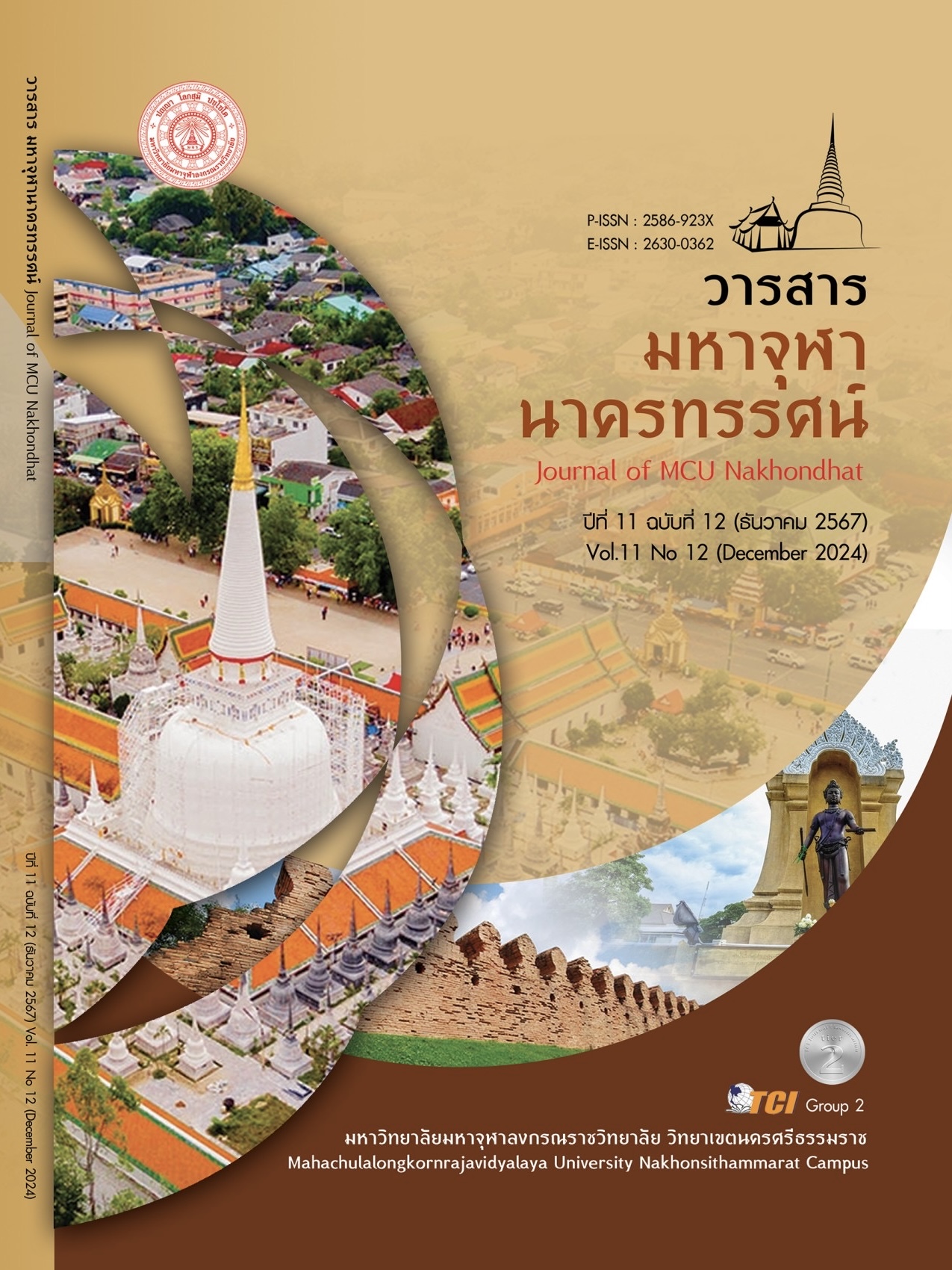KAYANAGARA: WONDERS OF THE UNIVERSE
Main Article Content
Abstract
This article aims to present ideas about the concept of the "Body City," the core teachings found in the literature of the Body City, and the influence of this literature on Thai society. The concept of "Body City" dates back to the time of the Buddha, who compared the human body to a city as a concrete teaching method. This comparison highlights the components of the human body and represents an important essence of Dharma that Buddhists should study for a clearer understanding to lead a virtuous life. The literature of the Body City consists of: 1) Form Aggregate, which includes the four great elements and 24 derived forms; 2) Feeling Aggregate, which encompasses happiness, suffering, and neutral feelings; 3) Perception Aggregate, referring to awareness or memory; 4) Mental Formations Aggregate, which describes the mind's tendencies to cultivate good or bad qualities; and 5) Consciousness Aggregate, which is the nature of awareness perceiving emotions through the senses. The structure of the Body City includes the four great elements: earth, water, fire, and air. The six gates of the city represent the six internal sense bases, with mindfulness as the gatekeeper. There are two envoys: concentration and insight meditation. Consciousness acts as the ruler of the Body City, while the four intersections in the city also correspond to the four great elements. The Noble Eightfold Path serves as a way to navigate within the city, and the ultimate truth, represented by Nibbana, serves as the royal decree. The literature of the Body City has influenced various aspects of Thai society, including art, traditions such as ordination, marriage, and funerals, as well as cultural beliefs related to Buddhism, becoming an integral part of Thai life from the past to the present
Article Details

This work is licensed under a Creative Commons Attribution-NonCommercial-NoDerivatives 4.0 International License.
References
ฉันท์ ขำวิไล. (2529). กายนคร. กรุงเทพมหานคร: โรงพิมพ์มิตรนราการพิมพ์.
ชวน เพชรแก้ว. (2520). การศึกษาวรรณคดีไทย. กรุงเทพมหานคร: สำนักพิมพ์อักษรสัมพันธ์.
พระครูโอภาสธรรมสาร (ชำนาญ โอภาโส). (2558). การศึกษาแก่นธรรมผ่านวรรณกรรมเรื่องกายนคร. ปทุมธานี: มหาวิทยาลัยมหาจุฬาลงกรณราชวิทยาลัย.
พระครูปลัดธรรมสรณ์ โสภาบุตร. (2561). แนวทางในการพัฒนาโรงเรียนวิถีพุทธตามหลักบวรแบบมีส่วนร่วมของผู้ปกครองในโรงเรียนเมืองโพธิ์ชัย อำเภอโพธิ์ชัย สังกัดสำนักงานเขตพื้นที่การศึกษาประถมศึกษาร้อยเอ็ด เขต 3. ใน วิทยานิพนธ์พุทธศาสตรมหาบัณฑิต สาขาวิชาการสอนสังคมศึกษา. มหาวิทยาลัยมหาจุฬาลงกรณราชวิทยาลัย.
พระครูปิยคุณาธาร สุจริตธุรการ และคณะ. (2563). รูปแบบการบริหารจัดการศูนย์การเรียนรู้เชิงพุทธบูรณาการสถานปฏิบัติธรรมโยคาวจร จังหวัดนครนายก. วารสาร มจร อุบลปริทรรศน์. 5(2), 453-464.
พระประชา ปสนฺนธมฺโม. (2535). เล่าไว้เมื่อวัยสนธยา อัตชีวประวัติของท่านพุทธทาส. กรุงเทพมหานคร: มูลนิธิโกมลคีมทอง.
พระพรหมดิลก. (2539). กายนคร. กรุงเทพมหานคร: โรงพิมพ์มหาจุฬาลงกรณราชวิทยาลัย.
พระมหาสุริยา มะสันเทียะ. (2558). กลยุทธ์การเพิ่มคุณค่าการตลาดสำหรับการท่องเที่ยวเชิงศาสนาของพระอารามหลวงในเกาะรัตนโกสินทร์. ใน ดุษฎีนิพนธ์บริหารธุรกิจดุษฎีบัณฑิต สาขาวิชาการตลาด. มหาวิทยาลัยสยาม.
พุทธทาสภิกขุ. (2513). คำอธิบายภาพปริศนาธรรมไทยชุดกายนคร. จัดพิมพ์เป็นธรรมทานสมโภชเปิดศูนย์หนังสือพุทธศาสนา. กรุงเทพมหานคร: ธรรมสภา.
มหาจุฬาลงกรณราชวิทยาลัย. (2539). พระไตรปิฎกภาษาไทย ฉบับมหาจุฬาลงกรณราชวิทยาลัย. กรุงเทพมหานคร: โรงพิมพ์มหาจุฬาลงกรณราชวิทยาลัย.


